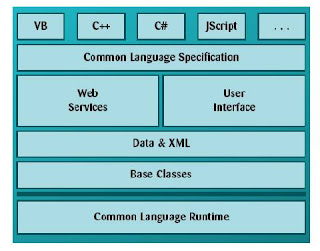Introduction to .Net Framework
Before learning C# it would be better to first understand the environment where C# programs are executed.
1. .NET Framework
The .NET Framework defines an environment that supports the development and execution of highly distributed, component-based applications.It enables differing computer languages to work together and provides for security, program portability, and a common programming model for the Windows platform. As it relates to C#, the .NET Framework defines two very important entities.
The first is the Common Language Runtime (CLR). This is the system that manages the execution of your program. Along with other benefits, the Common Language Runtime is the part of the .NET Framework that enables programs to be portable, supports mixed-language programming, and provides for secure execution.
The second entity is the .NET class library. This library gives your program access to the runtime environment. For example, if you want to perform I/O, such as displaying something on the screen, you will use the .NET class library to do it. If you are new to programming, then the term class may be new.
Although it is explained in detail later in this book, for now, a brief definition will suffice: a class is an object-oriented construct that helps organize programs. As long as your program restricts itself to the features defined by the .NET class library, your programs can run anywhere that the .NET runtime system is supported. Since C# automatically uses the .NET Framework class library, C# programs are automatically portable to all .NET environments.
2. Common Language Runtime
The Common Language Runtime manages the execution of .NET code. Here is how it works: When you compile a C# program, the output of the compiler is not executable code. Instead, it is a file that contains a special type of pseudocode called Microsoft Intermediate Language (MSIL). MSIL defines a set of portable instructions that are independent of any specific CPU.In essence, MSIL defines a portable assembly language. One other point: although MSIL is similar in concept to Java’s bytecode, the two are not the same. It is the job of the CLR to translate the intermediate code into executable code when a program is run.
Thus, any program compiled to MSIL can be run in any environment for which the CLR is implemented. This is part of how the .NET Framework achieves portability.
Microsoft Intermediate Language is turned into executable code using a JIT compiler. “JIT” stands for “Just-In-Time.” The process works like this: When a .NET program is executed, the CLR activates the JIT compiler. The JIT compiler converts MSIL into native code on demand as each part of your program is needed. Thus, your C# program actually executes as native code even though it is initially compiled into MSIL. This means that your program runs nearly as fast as it would if it had been compiled to native code in the first place, but it gains the portability benefits of MSIL. In addition to MSIL, one other thing is output when you compile a C# program: metadata. Metadata describes the data used by your program and enables your code to interact easily with other code. The metadata is contained in the same file as the MSIL.






0 Comments